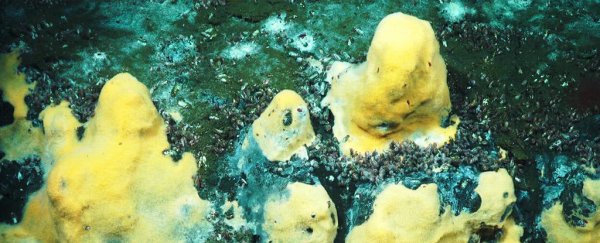One of the key steps to mitigating climate change is to better understand the multitude of factors that affect our planet's temperature – and a new study reveals the important role that ocean microbes play in the process.
Microbes are responsible for most of Earth's naturally produced methane, a key greenhouse gas that contributes to the warming of the atmosphere. But as well as producing it, microbes also consume it, keeping it trapped in the ocean.
The new research highlights how microbes in carbonate rocks such as limestone and dolomite play a crucial role in helping to regulate Earth's temperature by consuming methane and stopping it from escaping into the open air – a type of methane sink that has so far not been extensively studied.
"The microbes in these carbonate rocks are acting like a methane biofilter consuming it all before it leaves the ocean," says evolutionary biologist Peter Girguis from Harvard University.
 A carbonate rock chimney. (Schmidt Ocean Institute)
A carbonate rock chimney. (Schmidt Ocean Institute)
In lab tests, chimney-like carbonates collected off the coast of Southern California were shown to capture methane at some of the highest rates ever recorded, emphasizing how important these rocks are at keeping methane in check.
While carbonate rocks are common on the seafloor, the chimney-like structures studied here are quite unusual. The stacks resemble groups of underwater trees and can reach around 150 centimeters (59 inches) in height.
The channels formed by these rocks allow microbes to clump together in high densities, and researchers found that the chimney rock microbes eat up methane 50 times faster than seafloor sediment microbes. That's a big jump, and it seems that the structure of the rock plays a part.
These rocks are porous, which – again – isn't typical, and that may increase methane guzzling speed because it enables fresh supplies of the gas to be delivered all the time. The mineral pyrite may also play a role, acting as an electrical conduit and increasing the metabolic rate of the microbes.
"These chimneys exist because some methane in fluid flowing out from the subsurface is transformed by the microbes into bicarbonate, which can then precipitate out of the seawater as carbonate rock," says biologist Jeffrey Marlow from Boston University.
"We're still trying to figure out where that fluid – and its methane – is coming from."
In lab tests, the team put carbonate chimney rocks into high-pressure reactors to recreate the conditions on the sea floor. The methane consumption was compared with data from another three geological settings, ranging from the Gulf of Mexico to the coast of New England.
One of the more exciting parts of the research is that if we can figure out what the microbes are doing here, we might be able to recreate it in other locations – using natural methane sinks to soak up the gas when it escapes from landfills, for example.
While different rates in microbe methane capture have been noticed before – from volcanoes, for example – these peculiarly shaped carbonate stacks are the new winners. Now scientists want to find out more about how it works.
"Next we plan to disentangle how each of these different parts of the carbonates – the structure, electrical conductivity, fluid flow, and dense microbial community – make this possible," says Girguis. "As of now, we don't know the exact contribution of each."
The research has been published in PNAS.
